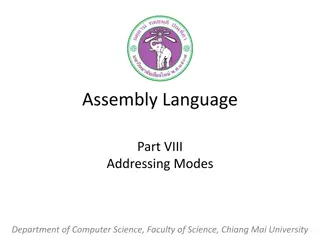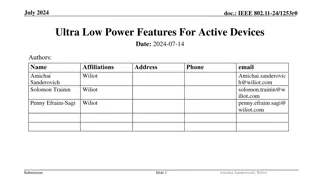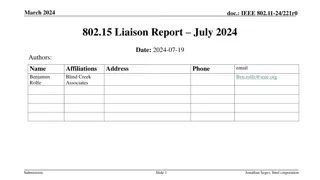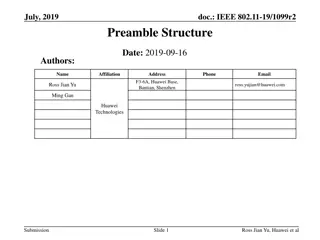AMP Link Access Modes in IEEE 802.11-24 Presentation
Presented in the March 2024 document IEEE 802.11-24/0421r0, Solomon Trainin from Wiliot discusses three modes of AMP link access, including random access of multiple AMP STAs, access of a single AMP STA, and exemplary frame exchanges for each mode.
Download Presentation

Please find below an Image/Link to download the presentation.
The content on the website is provided AS IS for your information and personal use only. It may not be sold, licensed, or shared on other websites without obtaining consent from the author.If you encounter any issues during the download, it is possible that the publisher has removed the file from their server.
You are allowed to download the files provided on this website for personal or commercial use, subject to the condition that they are used lawfully. All files are the property of their respective owners.
The content on the website is provided AS IS for your information and personal use only. It may not be sold, licensed, or shared on other websites without obtaining consent from the author.
E N D
Presentation Transcript
March 2024 doc.: IEEE 802.11-24/0421r0 AMP link access Date: 2024-03-10 Authors: Name Solomon Trainin Affiliations Wiliot Address Phone email solomon.trainin@wiliot.com Amichai Sanderovich Wiliot amichai.sanderovich@wiliot.com Penny Efraim-Sagi Wiliot penny.efraim.sagi@wiliot.com Submission Slide 1 Solomon Trainin, Wiliot
March 2024 doc.: IEEE 802.11-24/0421r0 Abstract Three modes of the AMP link access is presented and discussed. Submission Slide 2 Solomon Trainin, Wiliot
March 2024 doc.: IEEE 802.11-24/0421r0 Three modes of access # 1 Access Mode - Random access of multiple AMP STA - no RX (no Trigger frame) - AMP STA transmits broadcast addressed frame - Random access of multiple AMP STA - AMP STA receives groupcast addressed Trigger frame - AMP STA responds with unicast addressed frame 2 3 - Access of single AMP STA. AMP STA receives unicast addressed Trigger frame - AMP STA responds with unicast addressed frame Submission Slide 3 Solomon Trainin, Wiliot
March 2024 doc.: IEEE 802.11-24/0421r0 Exemplary frame exchange (access mode 1) The energizing ends at this point if it is supplied in the same channel as the CTS-to-self. Energizing Protection AMP AP STA Slots (Si) CTS to self AMP AP STA Frame control RA TA Response frame AMP-STA Response frame Mode Trigger frame Duration and Number of slots Comment RA TA 1 Does not present Preset out or the frame N/A (broadcast) N/A (broadcast) There might not be RA and TA in the frame format Submission Slide 4 Solomon Trainin, Wiliot
March 2024 doc.: IEEE 802.11-24/0421r0 Exemplary frame exchange (access mode 2) Protection Slot (Si) CTS to self Frame control RA TA Duration and Number of slots Trigger frame AMP AP STA Frame control RA TA Response frame AMP-STA Response frame Trigger frame Mode Comment Y/N RA TA Duration and Number of slots RA TA 2 Y Broadcast/ groupcast unicast >=1 unicast N/A There might not be RA in the Trigger frame format Submission Slide 5 Solomon Trainin, Wiliot
March 2024 doc.: IEEE 802.11-24/0421r0 Exemplary frame exchange (access mode 3) Protection Slot CTS to self Frame control RA TA Duration and Number of slots Trigger frame AMP AP STA Frame control RA TA Response frame AMP-STA Response frame Trigger frame Mode Comment Y/N RA TA Number of slots RA TA 3 Y unicast unicast 1 unicast unicast Submission Slide 6 Solomon Trainin, Wiliot
March 2024 doc.: IEEE 802.11-24/0421r0 Three modes of access - comparison AMP STA AMP AP STA # Mode Basic functionality Comments 1 Access of multiple AMP STA. Broadcast TX, no TX Broadcast frame during one of the preset access slots upon reaching the Energy threshold. The number and size of the TX energy signals No association/pairing, no individual addressing AMP STA no RX AMP AP STA transmits CTS_to_self frame at 2.4 GHz and a power signal simultaneously/sequentially, respecting 2.4 channel access rules. The protection set by CTS_to_self frame should cover the energy signal and the access slots [begin placing presentation body text here] RX. Keeps AMP STA incognito access slots are set by default. 2 Access of multiple AMP STA. Unicast TX, Broadcast RX. Keeps AMP STA incognito TX Unicast frame during one of the access slots when it is initiated by AMP AP STA. The number and size of the access slots can be set in the Trigger frame TX energy signals TX broadcast trigger frames at 2.4 GHz The number and size of access slots can be determined by the trigger frame. No association/pairing, no individual addressing. AMP AP STA broadcasts triggers. AMP STA responds with unicast frames to AMP AP STA AMP AP STA transmits trigger frame at 2.4 GHz also respecting 2.4 channel access rules. Using multicast addresses instead of broadcasting requires prior configuration in AMP AP STA. 3 Access of single AMP STA. Unicast TX, Unicast RX AMP STA does not save incognito TX Unicast frame following the Trigger frame when it is initiated by AMP AP STA. TX energy signals TX unicast trigger frames at 2.4 GHz Association/pairing, individual addressing. AMP AP STA TX unicast triggers AMP STA. The AMP STA responds with unicast frames to AMP AP STA AMP AP STA transmits trigger frame at 2.4 GHz also respecting 2.4 channel access rules. Point to point protection is achievable Submission Slide 7 Solomon Trainin, Wiliot
March 2024 doc.: IEEE 802.11-24/0421r0 Cons and Pros of different modes of Link Access Separation of energizing and communication in the bridges/AP is allowed # Pros Cons 1 No, an energy signal must be issued by an AMP AP STA simultaneously or sequentially with a CTS_ to_self frame, thus an AMP STA transmission initiated by an energy signal is protected by a CTS_ to_self frame - No RX - AMP AP STA triggers multiple AMP STAs in a single access, thereby reducing the number of channel accesses per AMP AP STA. - Through response broadcasting, multiple AMP AP STAs deliver the response frame of the same AMP STAs to upper layers of the network. This may enable some applications. - Keeps incognito of the AMP STA - No way to communicate with the AMP STA - Creates excessive link load due to multiple AMP AP STAs forwarding frames sent by AMP STAs - No information of link level delivery success - No link integrity 2 Yes, if the AMP STA is able waking up at the Trigger frame - AMP AP STA triggers multiple AMP STAs in a single access, thereby reducing the number of channel of channel accesses per AMP AP STA. - Keeps incognito of the AMP STA - No link between AMP STA and AMP AP STA - No information of link level delivery success - No link integrity 3 Yes, if the AMP STA is able waking up at the Trigger frame - Regular link level reliability is achievable - Regular link level integrity is achievable - AMP AP STA shall trigger each AMP STAs in a separate access, thereby increasing the number of channel accesses per AMP AP STA - Does not keep incognito of the AMP STA Submission Slide 8 Solomon Trainin, Wiliot
March 2024 doc.: IEEE 802.11-24/0421r0 Conclusion For AMP, three link access modes have been proposed and analyzed, which may be suitable depending on: method of energy supply (RF, solar energy ) application and associated operating conditions: density, frequency of accesses, movability, lifespan, accessibility for maintenance, etc. We recommend further investigation into the presented approaches as potential solution for the specification Submission Slide 9 Solomon Trainin, Wiliot
March 2024 doc.: IEEE 802.11-24/0421r0 References 1. 11-23-0774-00-0amp-wur-applicability-for-amp-downlink 2. 11-24-0047-01-0amp AMP Station operation states Submission Slide 10 Solomon Trainin, Wiliot























